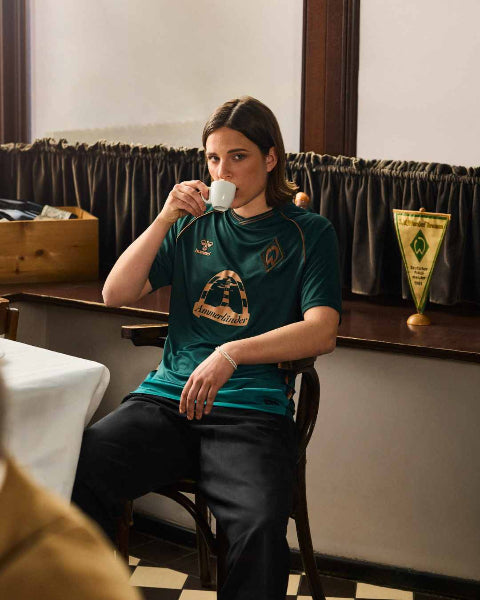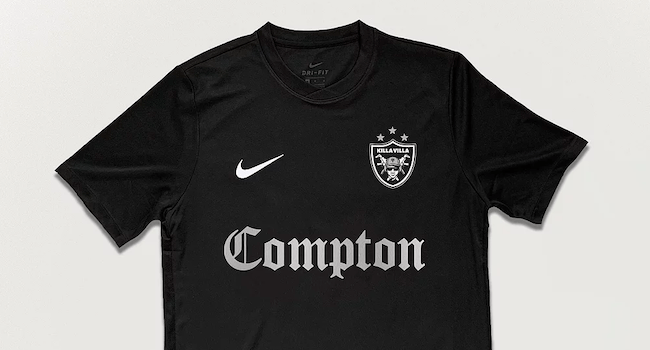Recently added
Vintage shirts
Concept kits
Legends
Template or teamwear – what’s the difference?
by Phil Delves February 05, 2022 4 min read

It’s new kit release season!
Football fans all over the globe are getting excited to see what their favourite team will wear next season and maybe buy the shirts themselves if they meet their high standards of “having some thought put into it and not being a template”. Oh wait – a template? What do you mean by template? See, most people confuse “templates” with “teamwear” and that’s what I’ll try – and probably fail - to clarify in this article.
What is a template?
A template – or, in industry terms, a chassis – is one of several options in collars, constructions and prints used by brands in an annual kit range. Templates are needed in the kit industry since, as kits need to be mass produced, machinery needs to be configured to produce the shirts in a certain way.
Of course, there’s still by-hand work going on, but not as much as there was in the past – hence the seeming rise of “templates”. It’s mostly a cost-cutting measure as it can be easily guessed, although one necessary in an increasingly demanding business.
What is teamwear?
Teamwear, on the other hand, is when one or more of these “templates” gets produced in a stock range of colourways, available for a fraction of the price of a branded shirt, for amateur and lower league teams to buy through retailers – as these teams cannot sign contracts directly with brands. Of course, we have seen top-tier teams use these options as well – it happens when said team has signed a deal too late into the kit design/selection process, or when the selling power of a team is not enough for a company to create bespoke designs for them.
Examples from recent history
According to multiple sources, this new Algeria shirt is our first look at the adidas Condivo 21 template. 👀 pic.twitter.com/E2gvcxahqy
— Football Shirt Collective (@thefootballsc) November 12, 2020
Probably the most infamous example of a template was Nike’s approach in the 2016 Euros – every nation was given the same base style, with only colours changing across teams. This was a policy adopted in order to promote the then-new Aeroswift technology, which was not yet advanced enough to provide the ability for bespoke prints on the shirts – the 16/17 kits that featured the prints lacked the signature “breast plate” mesh. This was not available on the teamwear catalogue until the following year – but its rigid use across the board, creating examples such as England and Paris St Germain having essentially the exact same away shirt, led to the misconception that it was teamwear.
2016/17 England player issue shirt from @shindles5 #england #englandfootball #football #fo… https://t.co/RA7N9rht0v pic.twitter.com/d4P50rzGNr
— Football Shirt Collective (@thefootballsc) June 11, 2016
Another more recent, slightly different example is the 20/21 Ajax away shirt. Due to its use on the Scotland away shirt as well as Ajax’s kit, a misconception that it was a part of the teamwear catalogue, similar to the designs of the previous two Ajax away shirts, was created and spread on social media. However, this is not an example of teamwear but an example of a “seasonal graphic”. What’s a “seasonal graphic”, you might ask?
What about seasonal graphics?
Every year, brand designers create a range of “seasonal graphics”. These are predominantly graphic prints, but they can also be a certain layout of vertical or horizontal stripes for example. For “tier B” teams that are often not demanding of a completely bespoke design, when communicating design concepts and ideas, brands present examples of these “seasonal graphics” that represent the horizontal direction of the company in terms of design (see the “brush stroke” theme for adidas in 2020). Every so often, clubs find that these graphics can work on their own, so choose one of said options.
In short, there’s a large difference between “teamwear” – stock options used by clubs that are not able to negotiate a more customized design for multiple reasons – and “templates” – which are divided to “base styles” and “seasonal graphics”. The latter have always been a thing – from the 1950s when every team used polo-collared tops because they were easier to source and mass produce, to the 1970s and Admiral and Umbro introducing the first examples of kit branding, then to the present day when your local Sunday League team can have designs also worn by top flight clubs…
Replica World Christmas Catalogue 1993#replicaworld #footballkit #replicafootballshirt pic.twitter.com/tH54GmZUKv
— John Devlin (@TrueColoursKits) June 17, 2020
Teamwear dates even further back, when teams, no matter their level, could order shirts in a multitude of colourways and designs via letters or phone calls – there’s Umbro catalogues dating as far back as 1935! Both aren’t a new phenomenon – and they’re not going away anytime soon. So, when your team releases a new kit that’s remotely similar to another team’s… just stop for a minute and whisper to yourself: “hey, it’s always been this way after all…”
If you enjoyed this blog on templates vs. teamwear, then why not sign-up to our weekly Collectors Club Newsletter to receive more great tips each week? You can sign-up here.
Phil Delves
As Head of Content, Phil is the creative playmaker of the team, covering every angle of football shirt news in our blogs and weekly Newsletter. Whether it's telling your fakes from your authentics, or deep dives into the newest football shirts designs, Phil will have all your football shirt content needs covered.
Sidebar
- Premier League football shirts
-
Other English clubs
- Birmingham City
- Blackburn Rovers
- Charlton Athletic
- Coventry City
- Derby County
- Hull City
- Ipswich Town
- Leicester City
- Middlesbrough
- Millwall
- Norwich City
- Portsmouth
- Preston North End
- Queens Park Rangers
- Sheffield United
- Sheffield Wednesday
- Southampton
- Stoke City
- Swansea City
- Watford
- West Bromwich Albion
- Scottish clubs
- Italian club shirts
- Spanish club shirts
- German club shirts
- International
- French club shirts
- Rest of the world
-
Legends
- Adriano
- Alessandro Del Piero
- Andrey Arshavin
- Alvaro Recoba
- Bobby Moore
- Bryan Robson
- Bukayo Saka
- Clarence Seedorf
- Cristian Vieri
- Cristiano Ronaldo
- David Beckham
- David James
- David Seaman
- David Ginola
- Dennis Wise
- Dennis Bergkamp
- Didier Drogba
- Dimitar Berbatov
- Diego Maradona
- Edgar Davids
- Eric Cantona
- Fernando Torres
- Freddie Ljungberg
- Gabriel Batistuta
- Gianluca Vialli
- Gianluigi Buffon
- Giovanni Elber
- Frank Lampard
- Francecso Totti
- Haaland
- Harry Kane
- Hidetoshi Nakata
- Ian Wright
- Jari Litmanen
- Ji Sung Park
- Juninho
- Jurgen Klinsmann
- Kaka
- Landon Donovan
- Lionel Messi
- Lothar Mattaus
- Luis Figo
- Mark Viduka
- Matt Le Tissier
- Mesut Özil
- Michael Owen
- Mikel Arteta
- Neymar
- Nicolas Anelka
- Nwankwo Kanu
- Paolo Di Canio
- Paolo Maldini
- Patrick Vieira
- Rafael Van der Vaart
- Raul
- Riquelme
- Rivaldo
- Robert Pires
- Roberto Baggio
- Robbie Fowler
- Ronaldo Nazario
- Ronaldinho
- Roy Keane
- Rudi Voller
- Ruud Gullit
- Ryan Giggs
- Santi Carzola
- Steve Bull
- Steven Gerrard
- Teddy Sheringham
- Thierry Henry
- Tony Adams
- Toto Schillaci
- Tugay
- Wayne Rooney
- Xabi Alonso
- Zinedine Zidane
- Zola
- Brands
Subscribe
Sign up to get the latest on sales, new releases and more …













